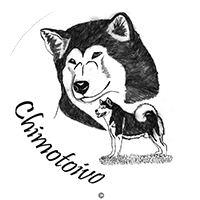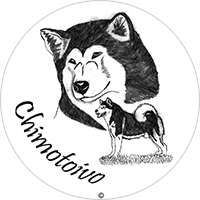Health of the Alaskan Malamute
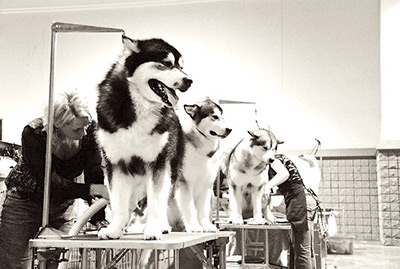 The Alaskan Malamute can get HD (hip dysplasia), Coat Funk (CF), Dwarfism (Chrondodysplasie), Epilepsy, Eye disorders (including Cone Degeneration Disease or CD and Cataract) and hypothyroidism (primary and secondary).
The Alaskan Malamute can get HD (hip dysplasia), Coat Funk (CF), Dwarfism (Chrondodysplasie), Epilepsy, Eye disorders (including Cone Degeneration Disease or CD and Cataract) and hypothyroidism (primary and secondary).
The chances these diseases occur in a dog with tested parents is much smaller than with non tested parents. So ask the breeder for the test results of the parents, a good breeder would love to show this to you and has copies of the results of the father, or can access them on internet.
The HD, Hypothyroidism and eye test are performed by a specialist. For HD is an X-ray picture taken and reviewd by the Administrative Board. The best outcome for HD is HD-A. With HD-B (transitional forms) may also be bred.
Care of the Alaskan Malamute
Daily treatment: with wide-toothed comb and brush aerate the coat. Be careful: don't pull out to much of the undercoat.
Big treatment: in moult, the undercoat comes loose, and also some of the top coat. The shephers rake takes out all hair that is loose. Rather not wash. The coat has no real tendency to tangle, except behind the ears and in the much longer hair on the tail, also in places where the hair is pressed together, as in the armpits. See if there is dirt in the eyes and clean them, clean the ears and clip nails if necessary. Cut the excess of hairs between the soles. Adventages and disadvantages of the coat: when well brushed, no substantial inconvencience of the hair. In the moulting period, much attention is needed, otherwise it tangles.
Malamutes are generally sensitive to cleaning products such as household cleaner and that kind of products. They can get a rash and itching. Also, when a Malamute gets too warm, he can get a rash.
Education of the Alaskan Malamute
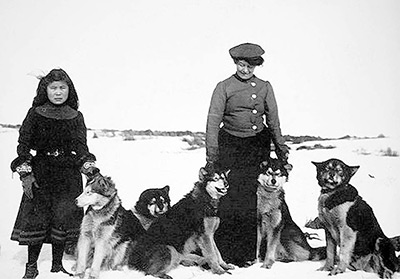 Despite his friendly nature, this dog must still be raised consistently. The owner needs to be strong-willed and understand the character of his Malamute. Under the guidance of such an owner this breed can learn a lot. Even dexterity is possible, though the Malamute will be overtaken in competition by dogs from the sheepdog group.
Despite his friendly nature, this dog must still be raised consistently. The owner needs to be strong-willed and understand the character of his Malamute. Under the guidance of such an owner this breed can learn a lot. Even dexterity is possible, though the Malamute will be overtaken in competition by dogs from the sheepdog group.
NOTE: a Malamute is very food focused and will have a strong instinct to feed. Once a positive experience with theft of food (from table eating cookie stealing etc, etc) then it is very difficult to unlearn.
When bored, a Malamute can show demolition behavior. A Malamute needs plenty of exercise, a large garden is NOT enough. He wants to explore.
A Malamute needs four years to grow complete.
Other information about the Alaskan Malamute
The height of males is about 63 to 75 cm and of females about 58 to 65 cm. The weight of a male is between 36 and 45 kg, of the female between 30 and 38 kg. (The North/Central American Kotzebue line over 60 kg, there is a known dog that has a height of 110cm). The Malamute has a medium length double coat. Usually they are white with gray, but in general all colors are permitted. They have pointed, rounded up ears.
The Kotzebue and M'loot line a double row of teeth. (The North American Kotzebue line usually does not). However, these are not the original Alaskan Malamutes. This was adopted in America, it's not recommended to buy these dogs because they have their overwhelming problems with their joints.
Alaskan Malamute puppy purchase
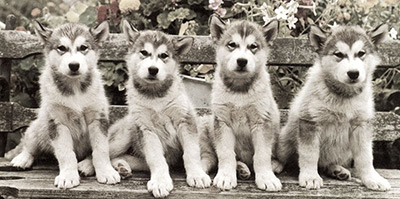 Note that puppies grow up in a homely atmosphere with mother dog, and both parent dogs have no inheritable diseases.
Note that puppies grow up in a homely atmosphere with mother dog, and both parent dogs have no inheritable diseases.
A puppy will cost between 900 and 2500 euros, this varies a lot. It depends on the bloodline and show results. First think of what you really want, a show dog or a working dog, but this doesn't mean a show dog will not work or a working dog can not do shows. But a working dog is more selected for his working skills than for his looks, with a show dog the other way around. Certainly is for an Alaskan Malamute: Look before you leap, do not be seduced by the ball of wool that sprints around, this ball of wool becomes big with a very large force that must be carefully managed.
Source: hondenpage.com
